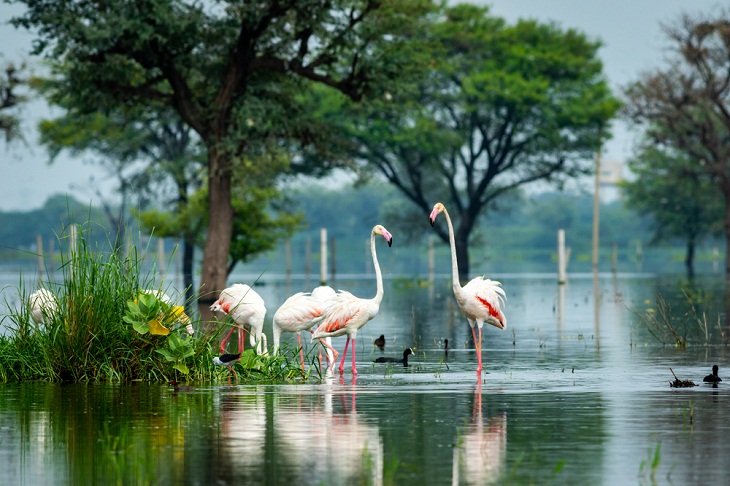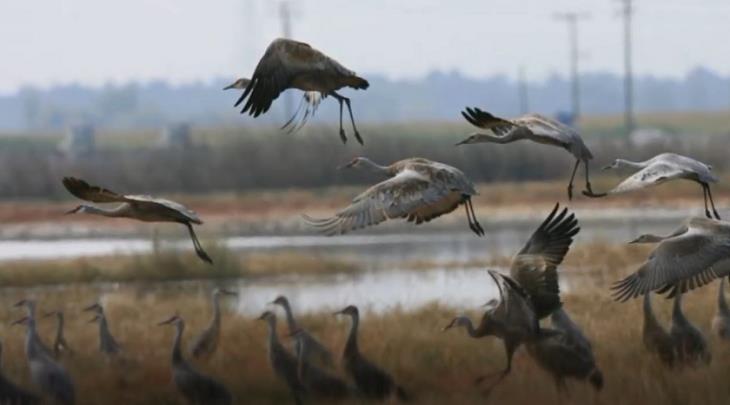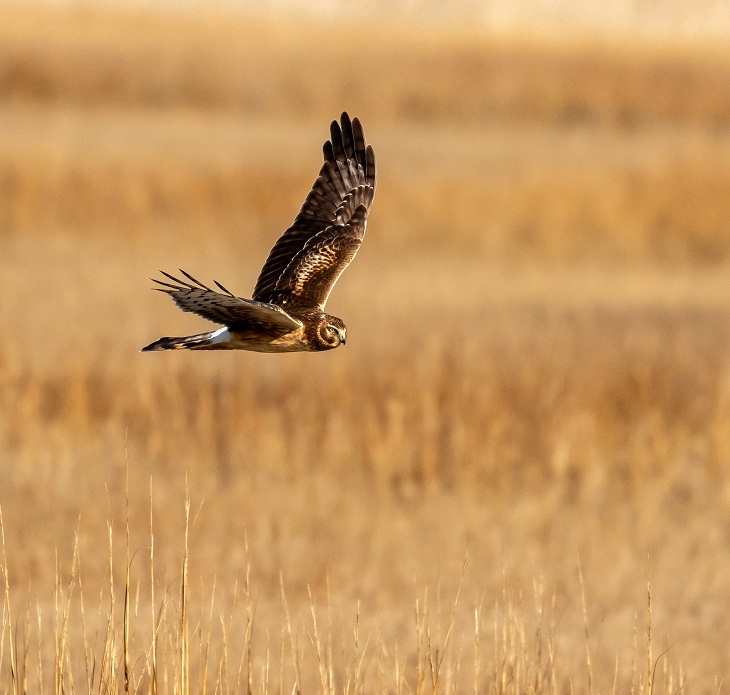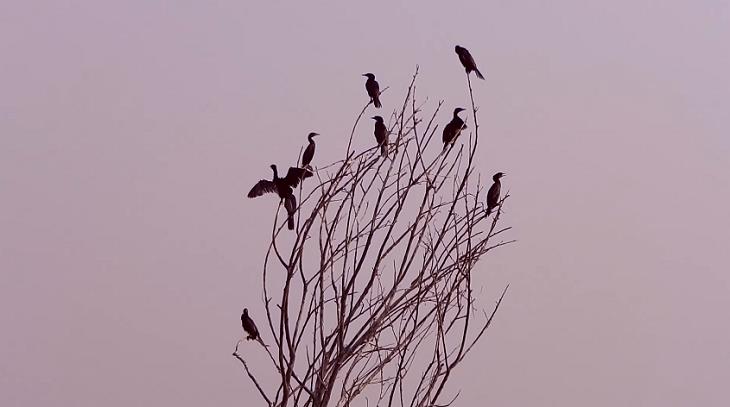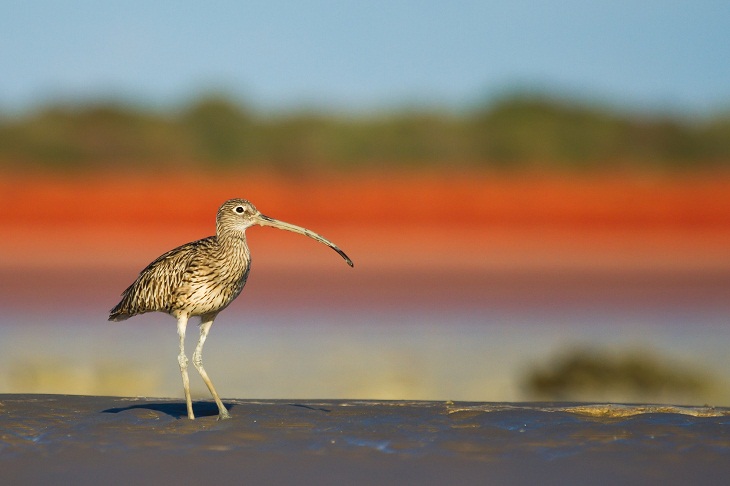Greater flamingoes flock the Bharatpur Bird Sanctuary during the monsoon season
Nestled in the enchanting landscapes of Rajasthan, India, the Bharatpur Bird Sanctuary (now known as Keoladeo National Park) serves as a seasonal sanctuary for the majestic Siberian Cranes, which grace its tranquil shores during the winter months. In the past, the park served as a favored hunting ground for the Bharatpur maharajas, who upheld the tradition since 1850 by organizing annual duck shoots to honor the British viceroys. However, in 1982, Keoladeo transformed into a national park, earning UNESCO's esteemed World Heritage Site status in 1985.
Spanning 29 square kilometers (12 square miles), the wildlife park comprises 11 square kilometers (4.2 square miles) of marshes, and the remaining area consists of grasslands and shrublands. Within this diverse ecosystem, over 300 bird species find their home, making it a remarkable sanctuary for avian life.
2. Djoudj National Bird Sanctuary, Africa
Hunting white pelicans at the lake in Djoudj National Bird Sanctuary
Located within the Senegal River delta, the Djoudj bird sanctuary encompasses a diverse array of habitats, spanning approximately 160 square kilometers. This UNESCO World Heritage Site comprises rivers, seasonal pools, a vast lake, lily-filled shallows, and expansive floodplains. An astonishing assemblage of over 1.5 million birds resides within its borders, including magnificent white pelicans, elegant purple herons, African spoonbills, majestic great egrets, and countless migratory species.
In the past, the sanctuary experienced alternating cycles of seasonal floods and oceanic saltwater influxes. However, these natural fluctuations were rectified through the construction of upstream and downstream structures. With its rich range of wetland ecosystems, the Djoudj bird sanctuary serves as a magnet for migratory birds, especially those embarking on arduous journeys across the Sahara. Among the sanctuary's avian inhabitants, pelicans and flamingos reign as the most frequently observed species, adding to the sanctuary's allure and enchantment.
3. Harry Gibbons Migratory Bird Sanctuary, Canada
Sandhill cranes take flight in the Harry Gibbons Migratory Bird Sanctuary (Image source:
WellBorn TV/YouTube)
During the 1950s, the Canadian Wildlife Service established the Harry Gibbons Migratory Bird Sanctuary, recognizing its significance as a crucial nesting site for snow geese. However, over time, it became evident that the sanctuary provided shelter not only for geese but also for a plethora of bird species seeking a safe haven during the breeding season.
Encompassing an impressive expanse of five kilometers (3 miles) in width and 13 kilometers (8 miles) in length, this sanctuary is now home to a diverse array of avian inhabitants, including Pacific loons, Tundra swans, king eiders, Atlantic brants, and many more. While the landscape features scattered water patches, the park is dominated by sprawling meadows adorned with vegetation. Several access points allow visitors to admire these remarkable birds, but it is essential for all visitors to honor both the land and the wildlife by practicing the utmost respect and care.
4. Norman Bird Sanctuary, USA
Located in Middletown, Rhode Island, Norman Bird Sanctuary is a nonprofit wildlife sanctuary and environmental education center dedicated to preserving and protecting wild birds. The sanctuary was established in 1949 by Mabel Norman Cerio with the goal of developing a place where birds and bird life could be observed, studied, taught, and appreciated by nature lovers and the general public. This place now spans over 325 acres across various habitats, including ponds/streams, woodlands, and fields. Norman Bird Sanctuary is known for having a diverse set of birds in each habitat, such as blue jays, the downy woodpecker, the black-capped chickadee, the red-winged blackbird, the American goldfinch, and many others.
5. Nal Sarovar Bird Sanctuary, India
Cormorants, also known as snake birds, flock together in the Nal Sarovar Bird Sanctuary (Image source:
YouTube/Traveling Eyesight)
The serene Nal Sarovar Bird Sanctuary in Gujarat, India, is a cherished retreat for those who appreciate birds and the wonders of nature. Spread over an expansive area of 120 square kilometers (46 square miles), this sanctuary encompasses a serene lake and marshlands, making it an ideal habitat for a diverse range of migratory and resident bird species. The sanctuary is renowned for its picturesque landscapes, offering a breathtaking backdrop for birdwatching and photography. Visitors can witness the mesmerizing sight of thousands of birds, including flamingos, pelicans, herons, ducks, and many others, flocking to the sanctuary during the winter months.
A boat excursion into the park provides an up-close encounter with the remarkable diversity of birds and the tranquility of the surrounding natural environment.
6. Bear River Migratory Bird Refuge, USA
Established in 1928, this remarkable refuge spans over 74,000 acres, encompassing a diverse range of habitats such as wetlands, open water, mudflats, and upland areas. It serves as a critical stopover point along the Pacific Flyway, providing vital resting, feeding, and breeding grounds for millions of birds. The Bear River Migratory Bird Refuge is home to over 200 bird species, including majestic waterfowl, shorebirds, raptors, and songbirds. The park offers unparalleled opportunities for visitors to observe and appreciate the rich avian diversity through scenic drives, hiking trails, and observation points.
7. Broome Bird Observatory, Australia
For avid birdwatchers, the Broome Bird Observatory is a veritable paradise, boasting an impressive count of 50 shorebird species from around the world and over 300 of Australia's 800 species. Located along the mudflat shores of Roebuck Bay, this observatory is a key meeting place for migrating birds. With its diverse range of habitats, it presents an ideal location for avid birdwatchers to check off their bird-watching lists.
Before their annual migration to Asia in March/April, vast flocks of migratory birds scour the mudflats in search of food, creating a captivating sight. Additionally, bird enthusiasts benefit from the convenient access to the bay. The species composition varies with the changing seasons, offering frequent sightings of yellow-chats and an array of 22 raptor species in the region.

